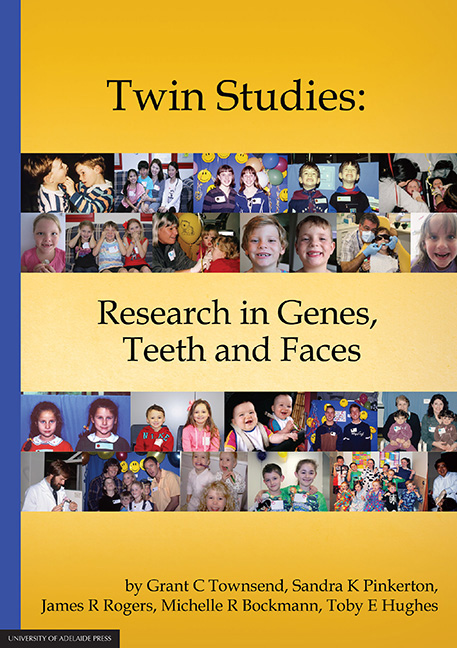Book contents
- Frontmatter
- Foreword
- Preface
- Dedication
- Photographic acknowledgements
- Ethical approval
- Acknowledgements
- Contents
- Chapter One A tour of the mouth
- Chapter Two A historical perspective
- Chapter Three Phases of research involving twin studies of teeth and faces
- Chapter Four Cohort 1: Teeth and faces of South Australian teenage twins
- Chapter Five Cohort 2 – A longitudinal study of dental and facial development in Australian twins and their families
- Chapter Six Cohort 3 – Tooth emergence and oral health in Australian twins and their families
- Chapter Seven Publications and theses relating to the Adelaide Twin Studies
- Glossary of terms
- Appendix 1
Preface
Published online by Cambridge University Press: 05 February 2016
- Frontmatter
- Foreword
- Preface
- Dedication
- Photographic acknowledgements
- Ethical approval
- Acknowledgements
- Contents
- Chapter One A tour of the mouth
- Chapter Two A historical perspective
- Chapter Three Phases of research involving twin studies of teeth and faces
- Chapter Four Cohort 1: Teeth and faces of South Australian teenage twins
- Chapter Five Cohort 2 – A longitudinal study of dental and facial development in Australian twins and their families
- Chapter Six Cohort 3 – Tooth emergence and oral health in Australian twins and their families
- Chapter Seven Publications and theses relating to the Adelaide Twin Studies
- Glossary of terms
- Appendix 1
Summary
This volume is about an ongoing long-term research initiative led by researchers from the School of Dentistry at the University of Adelaide. The aim of this book is to provide an overview of our studies of the teeth and faces of Australian twins and their families — studies that have extended over more than thirty years. Rather than providing detailed accounts of the methodologies and results of each of the individual research projects, we have provided general descriptions of the approaches that have been adopted, and have emphasised some of our key findings.
The book is aimed primarily at the participants of our studies — over 1200 pairs of twins and more than 2000 of their family members — as well as other families of twins who may be interested in being involved in future research projects. A common question asked by participants over the years has been, ‘What have you found?’ We now hope that these generous people, without whom our studies would have been impossible, will enjoy reading about our research in a single volume, rather than having to go through a large number of more focused, technical articles published in various journals.
The book provides some historical perspectives of studies of twins, including those involving teeth and faces. It also gives an insight into the technological and scientific changes that have occurred over the past thirty years, including various twin models that enable exploration of genetic, epigenetic and environmental contributions to variation in teeth and faces. For this reason, it should also be of interest to students planning to undertake research involving twins, as well as to researchers and academics in the fields of dentistry and craniofacial biology. We are now in the so-called ‘omics’ era, but the importance of twin studies has not diminished, as some had predicted it would. Rather, studies of twins and their families have become even more relevant to understanding how genetic, epigenetic and environmental factors contribute to observed variation in health and disease.
One of the features of the studies described in this book is that several of them incorporate a longitudinal design, meaning that the twins were examined on more than one occasion. This has enabled questions to be asked about how genetic factors influence growth and development over time.
- Type
- Chapter
- Information
- Twin StudiesResearch in Genes, Teeth and Faces, pp. viii - xPublisher: The University of Adelaide PressPrint publication year: 2015

